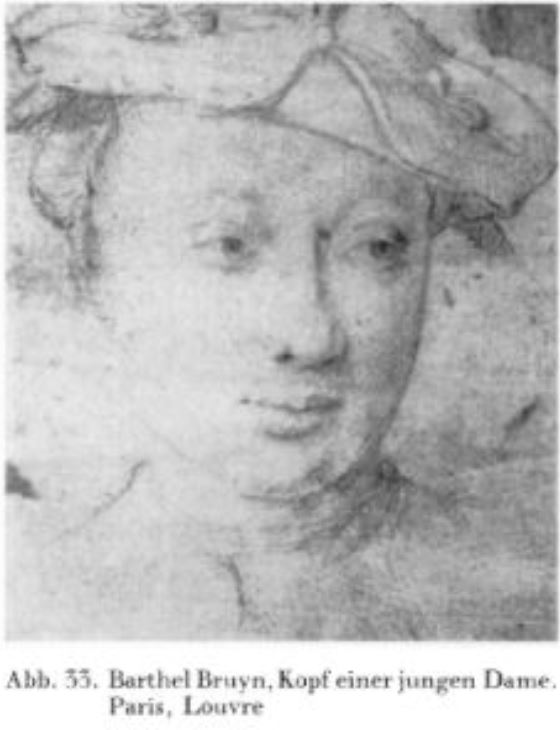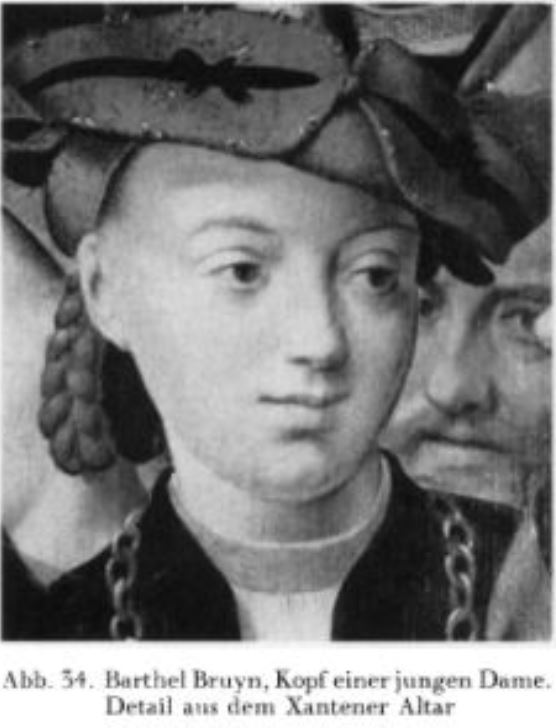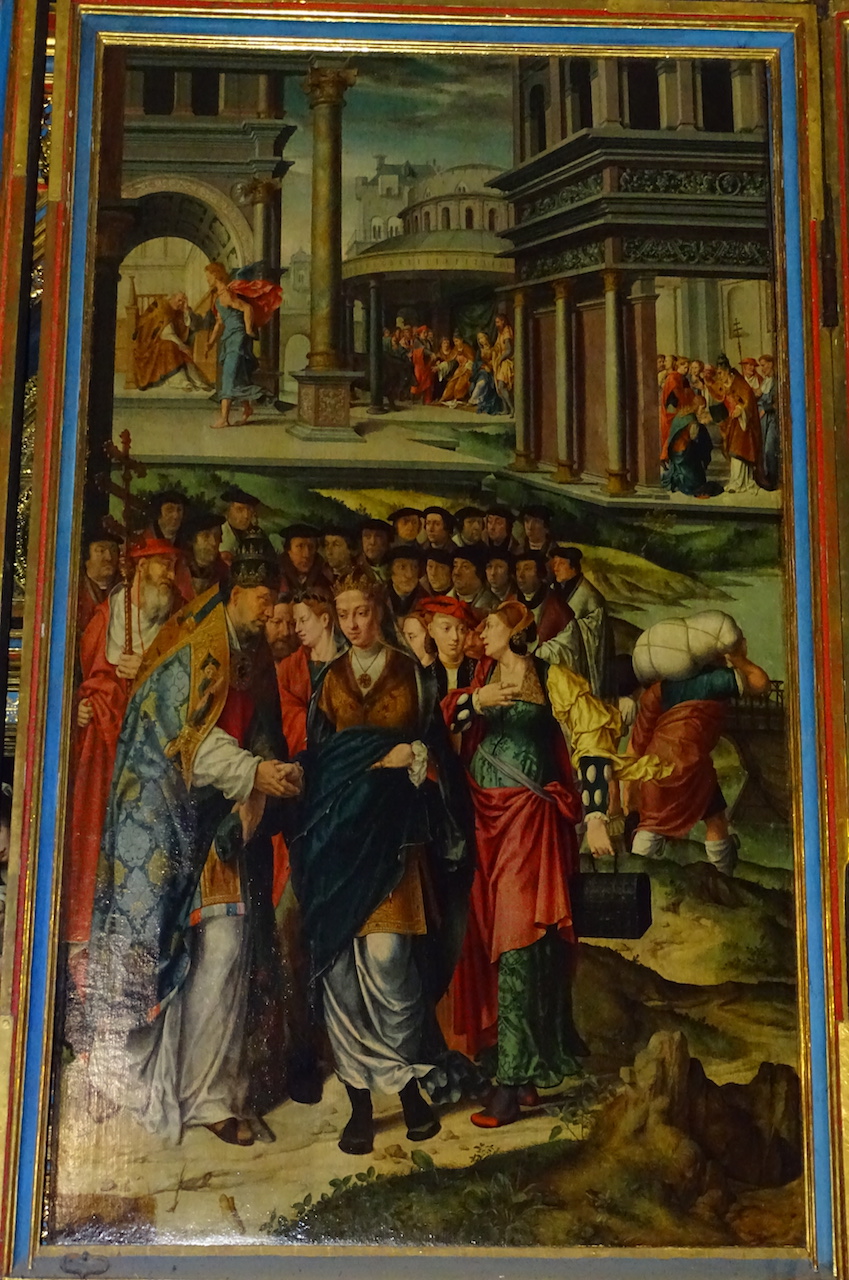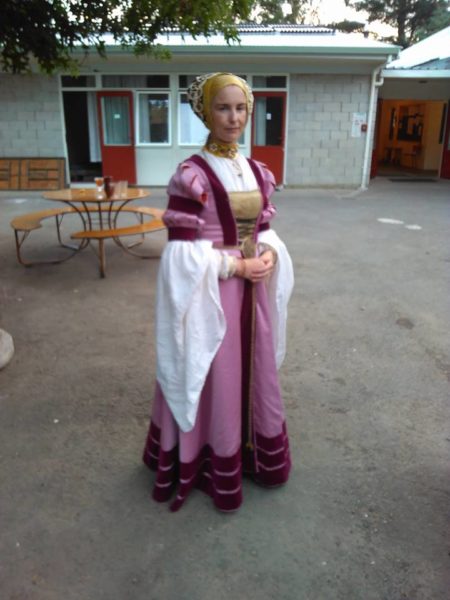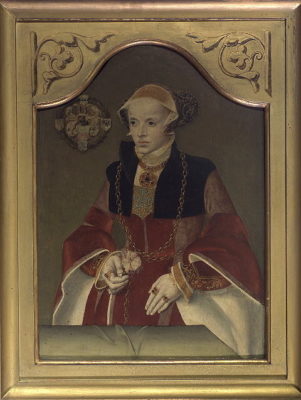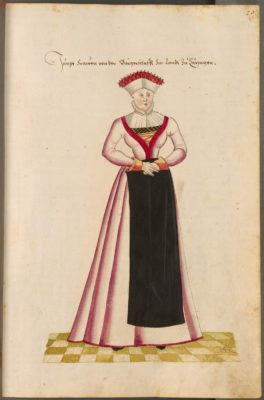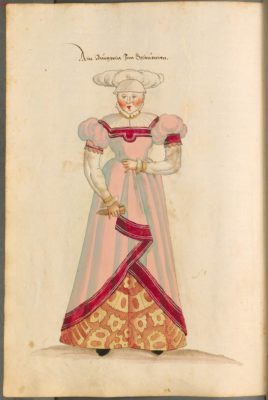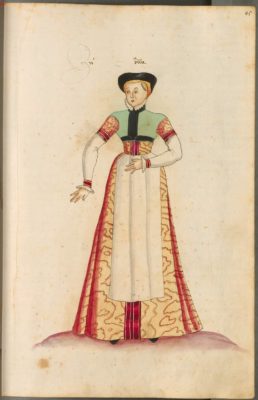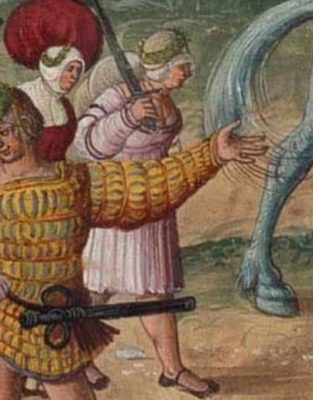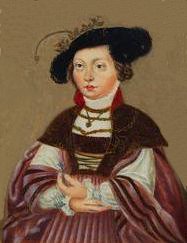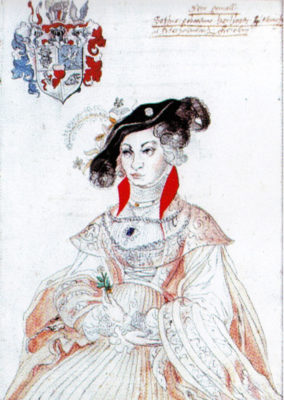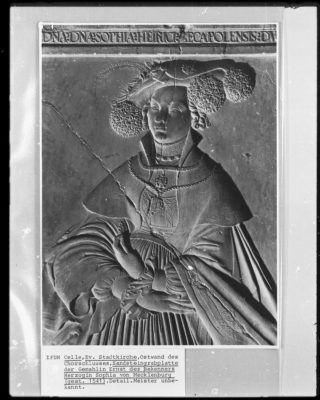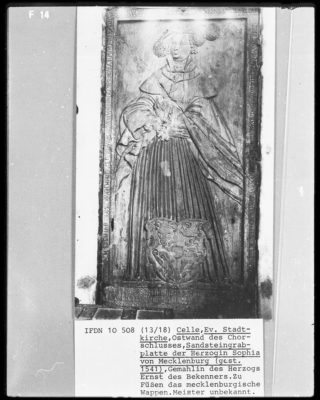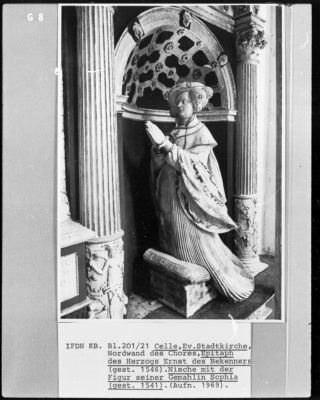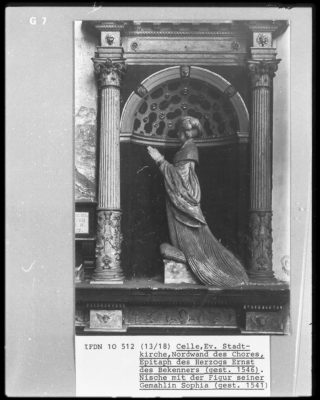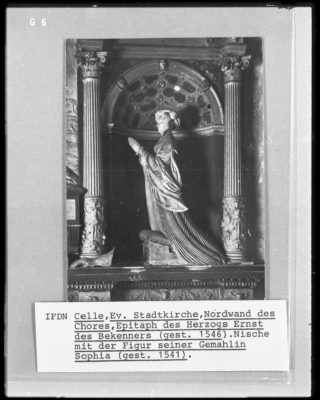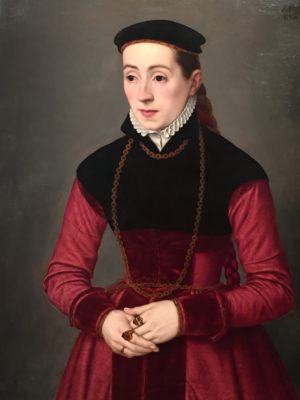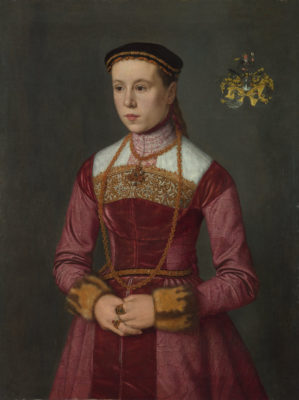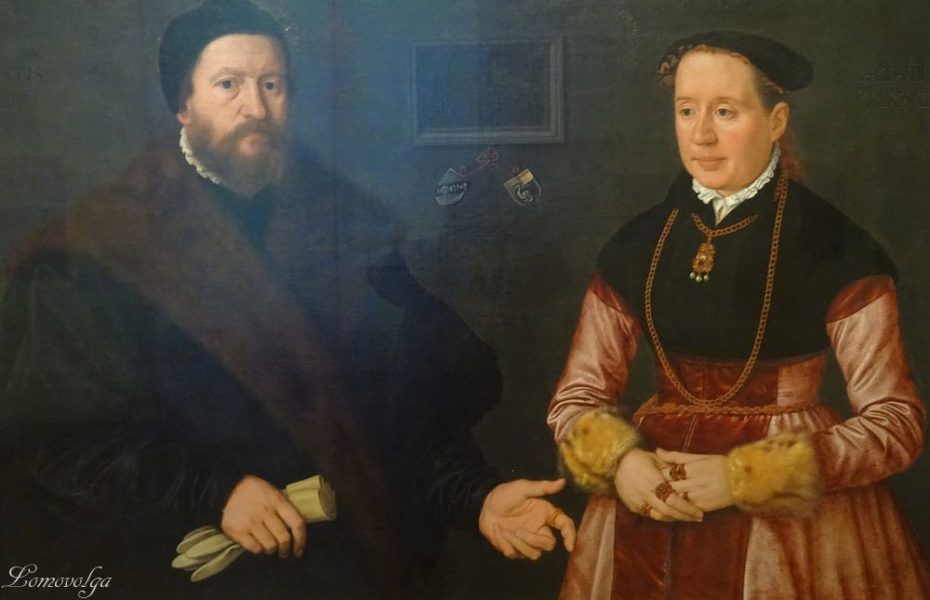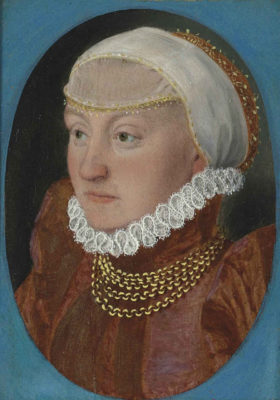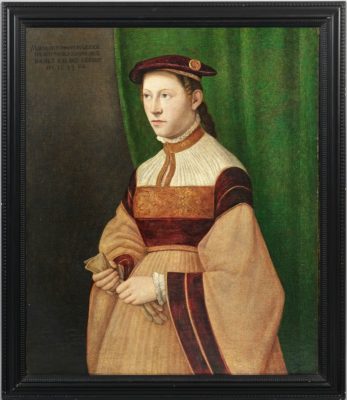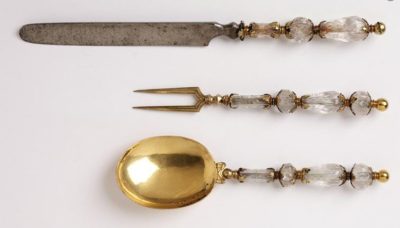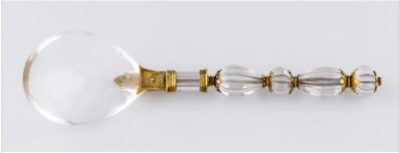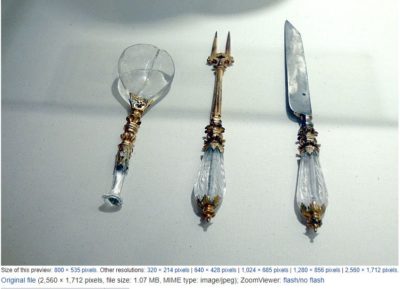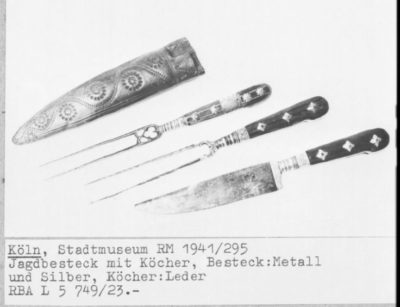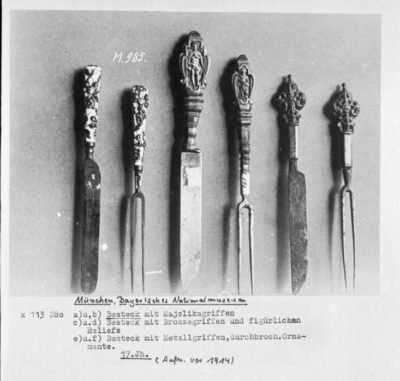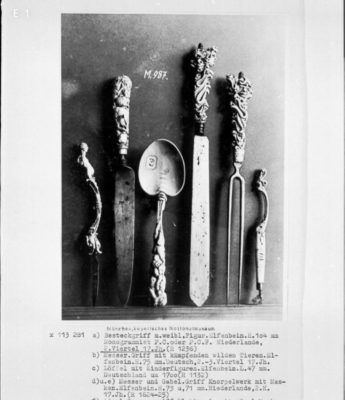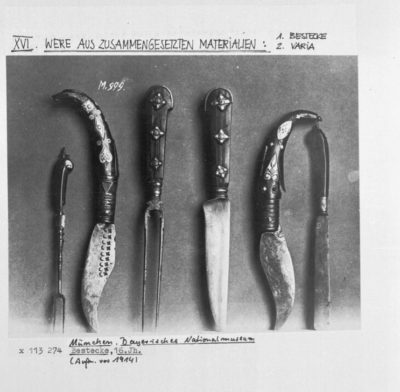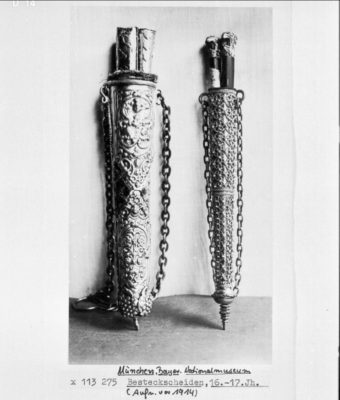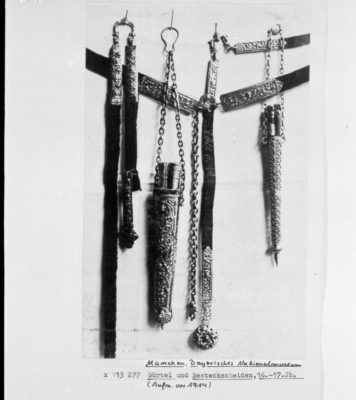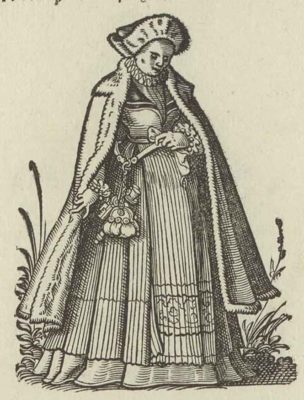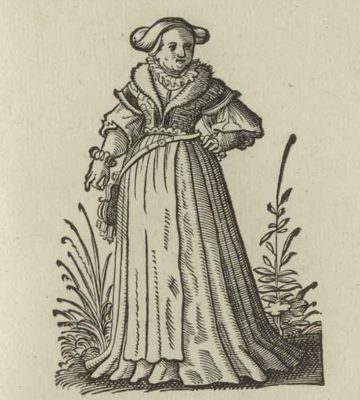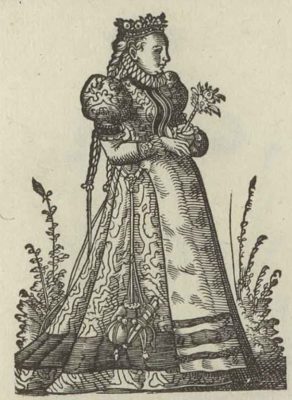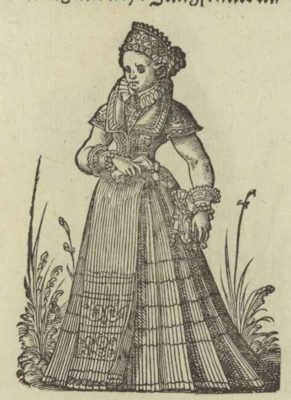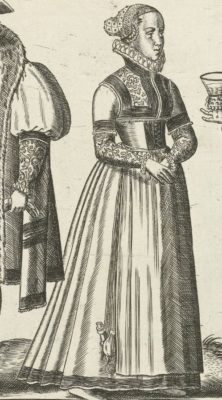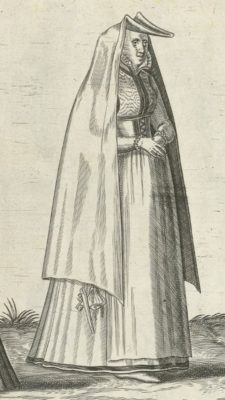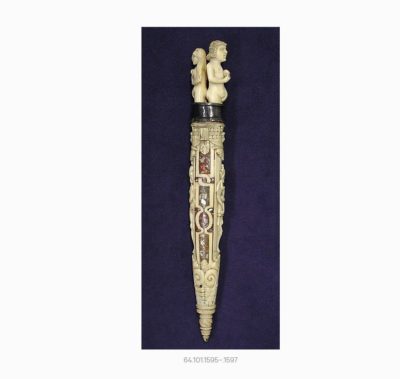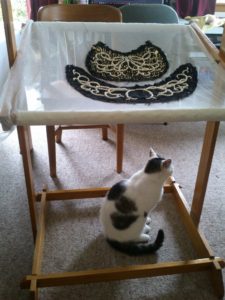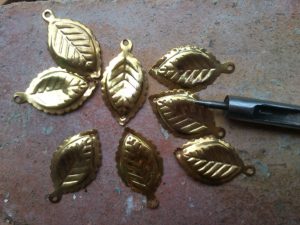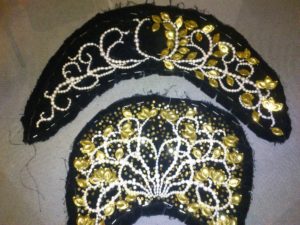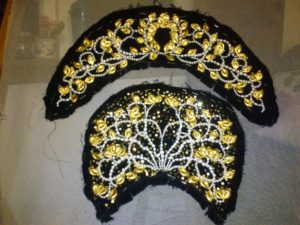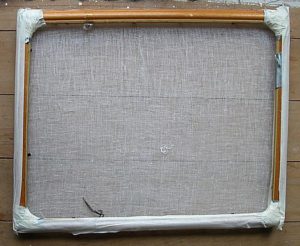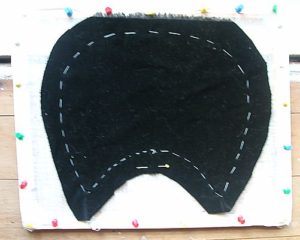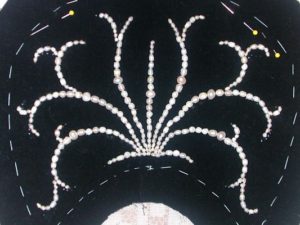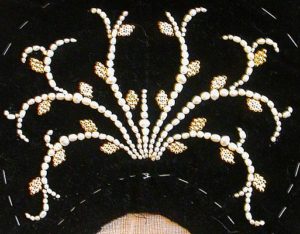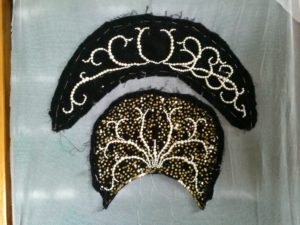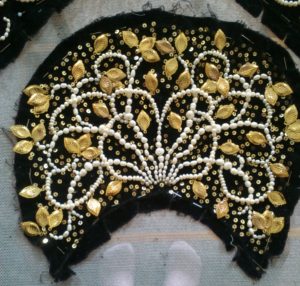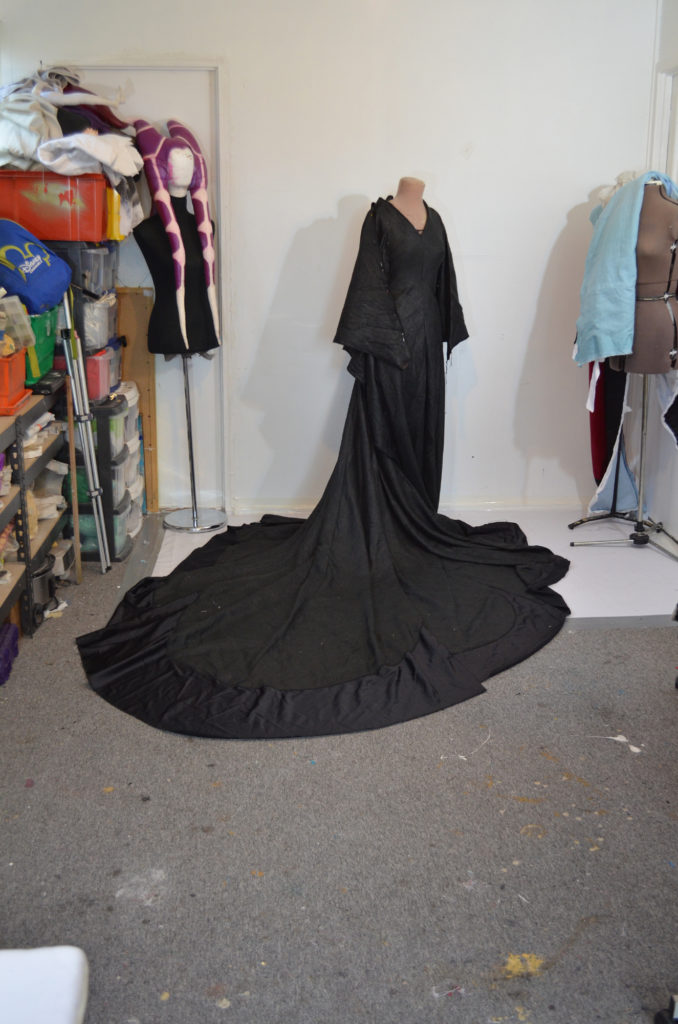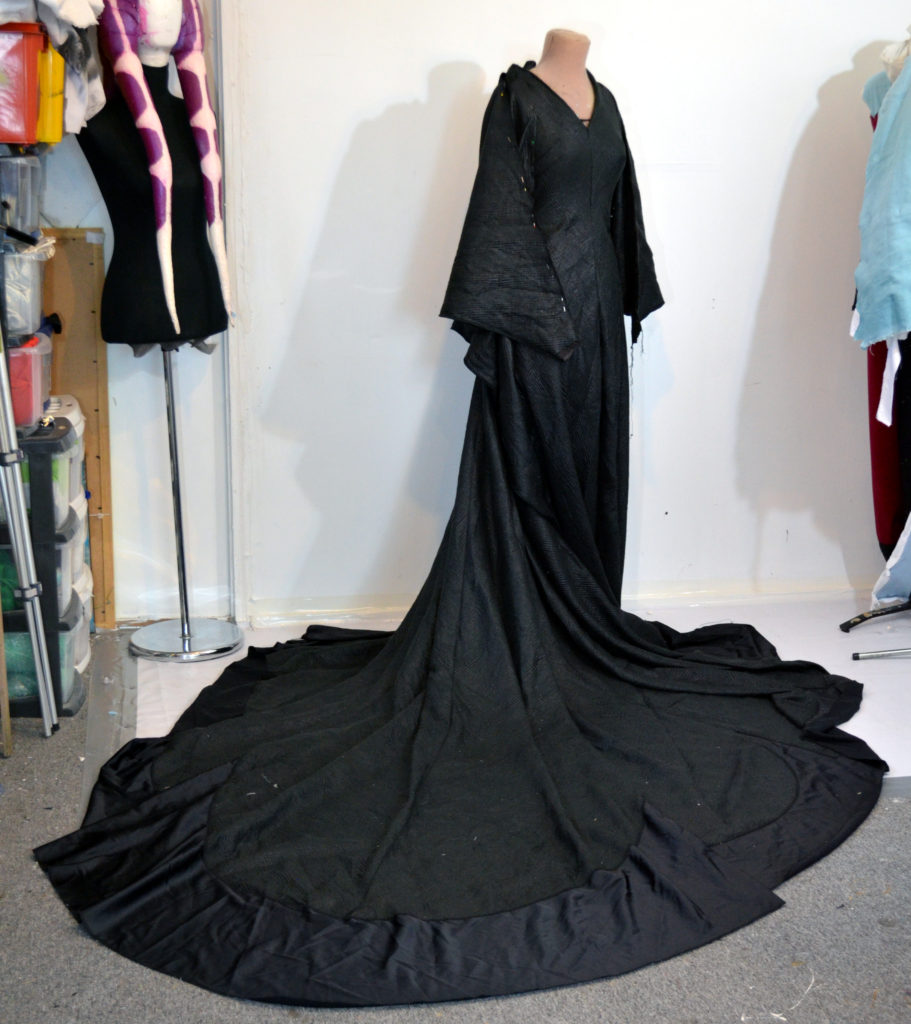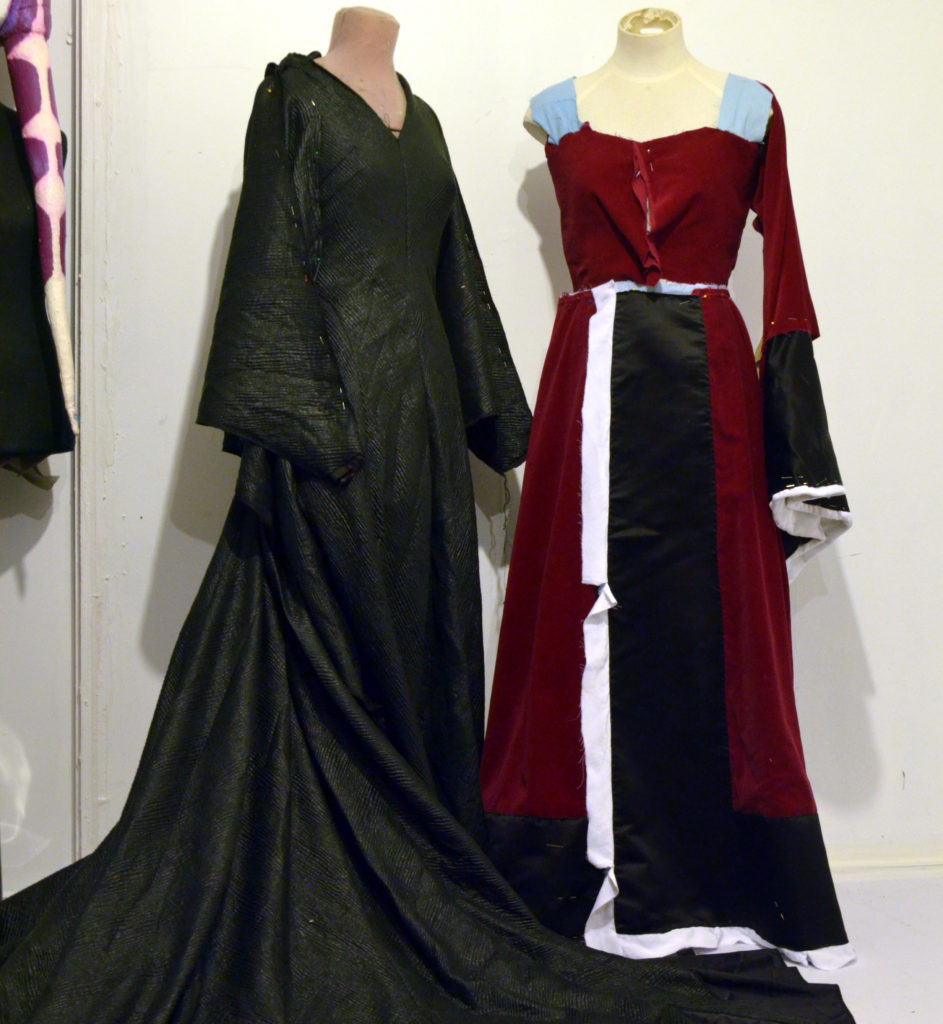Juelich sleeves as depicted in the Codice de Trajes
I have been trying to work out if the Codice de Trajes can be trusted for the figures of women from Juelich. These are a lot of figures with nearly the same dress and sleeve arrangement after all and this is not an arrangement we see in the Bruyn portraits of women of Cologne.
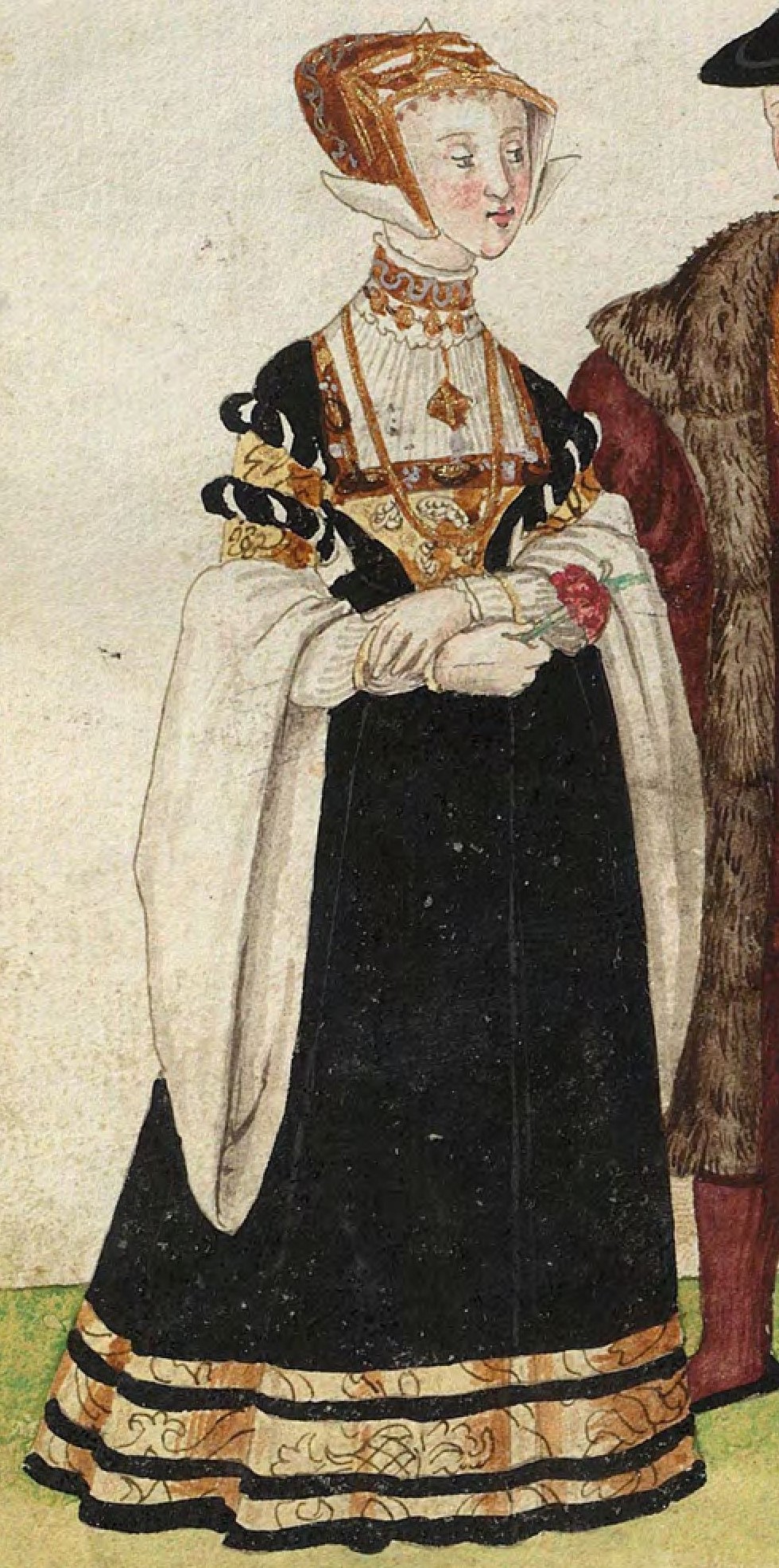
1540s Julich nobility. Fig. 1, plate 42v, Codice de trajes, Christoph Weiditz. BNE bdh0000052132 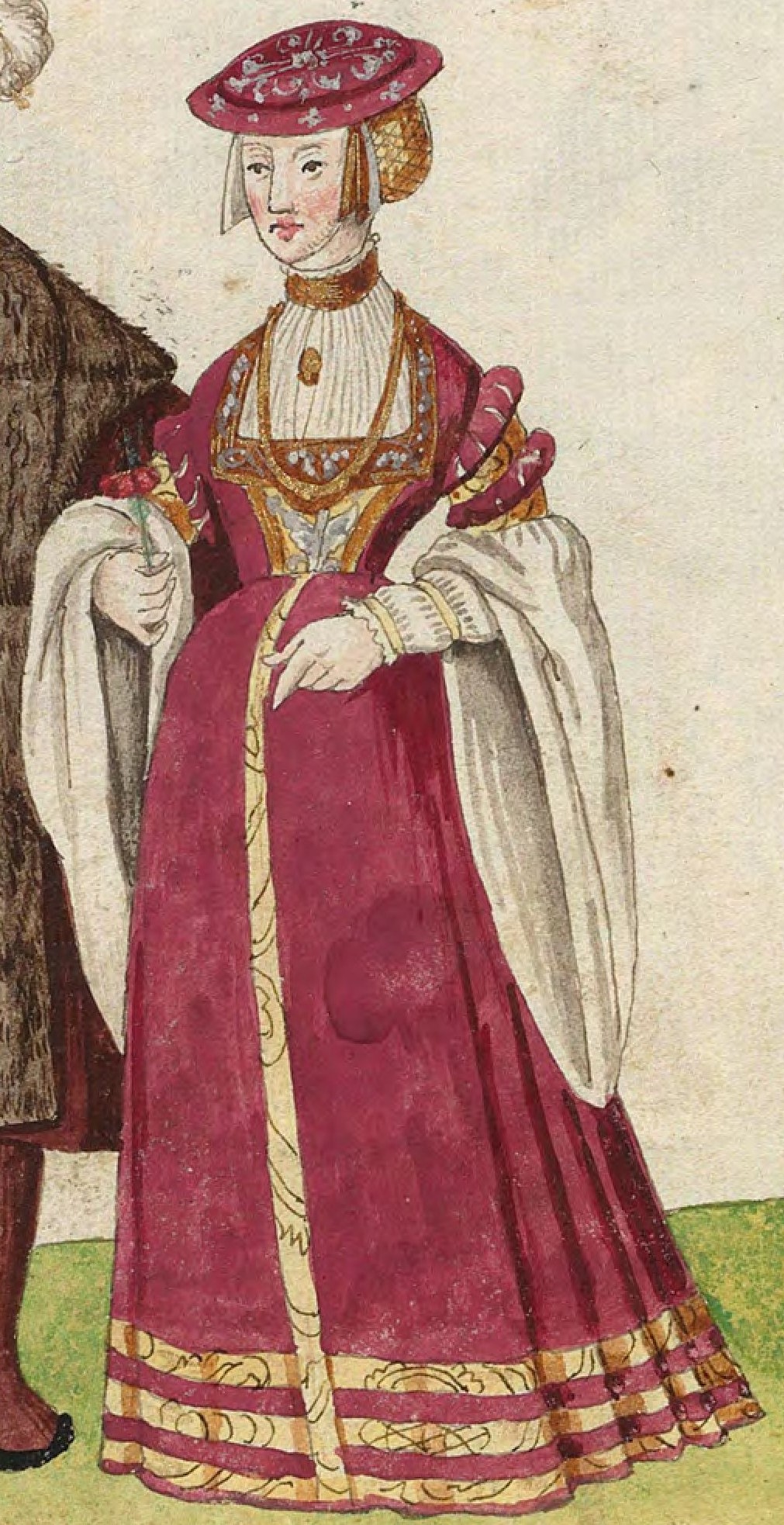
1540s Julich nobility. Fig. 3, plate 42v, Codice de trajes, Christoph Weiditz. BNE bdh0000052132 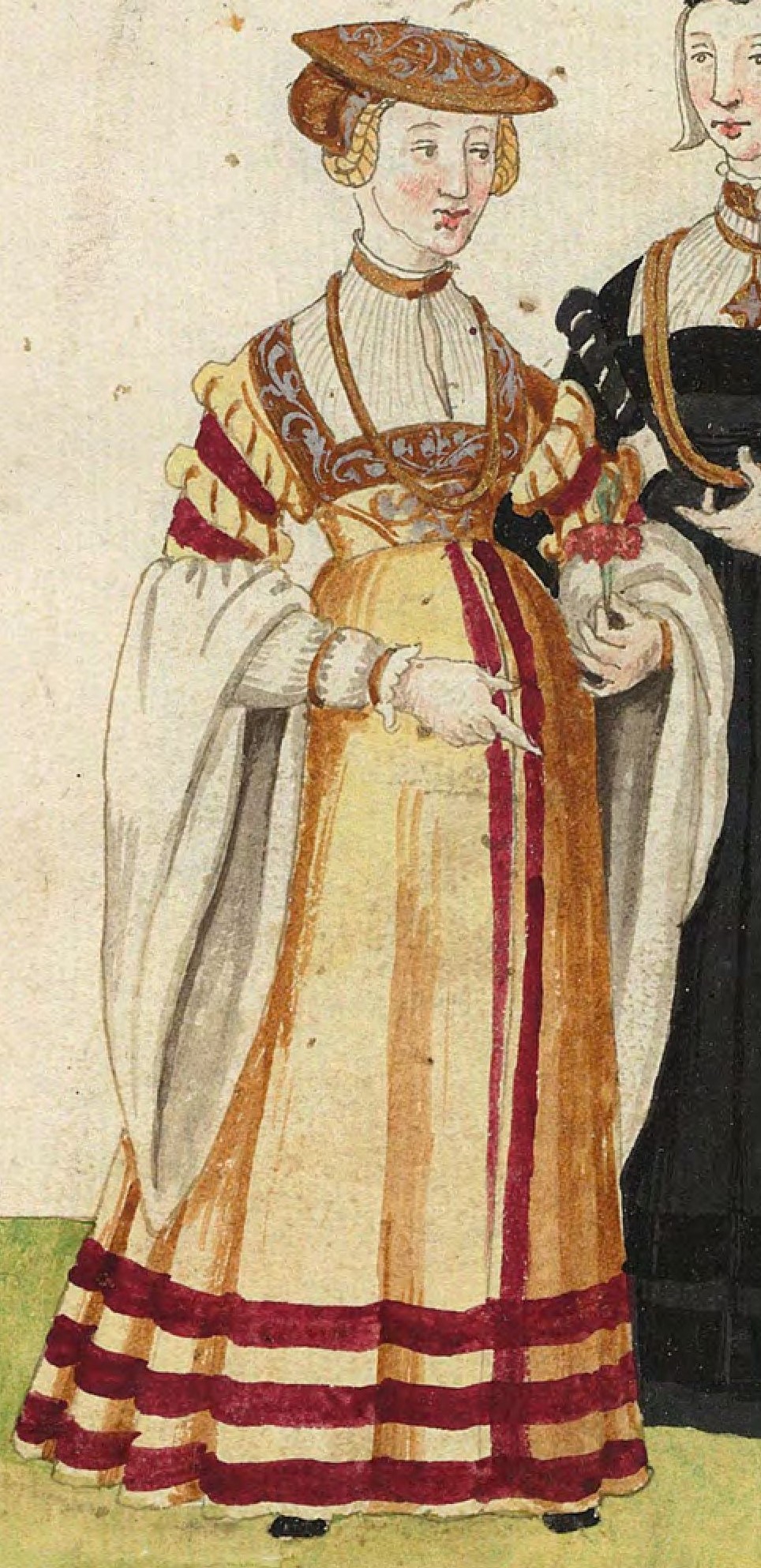
1540s Julich citizen. Fig. 1, plate 43r, Codice de trajes, Christoph Weiditz. BNE bdh0000052132 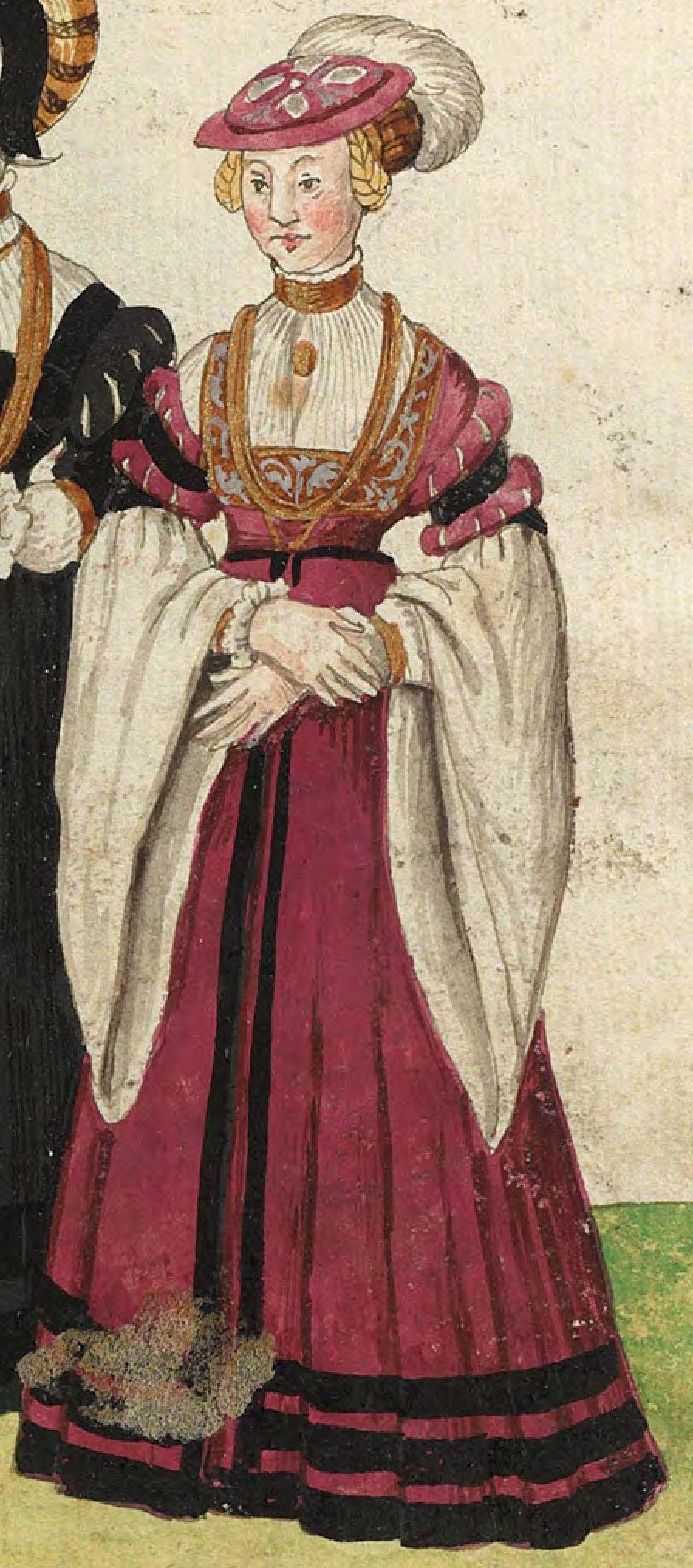
1540s Julich citizen. Fig. 3, plate 43r, Codice de trajes, Christoph Weiditz. BNE bdh0000052132
I decided to treat these images as if they are representative of what I haven’t seen before, after all the rest of the figures really do match very well to imagery we have of dress across Europe.
We have a wealth of portraits of wealthy citizens of Cologne and a few precious images of Anna and her family. And these fragments of information do support this position as there are marked differences in style while maintaining features iconic of the region.
I am used to hanging sleeves of this region being made from the same fabric as the rest of the gown and lined in fur- and indeed even a very very fine fur that is often depicted as very delicate and very short and a very soft and thin skin- sometimes shown with the tails more often not. Sometimes these sleeves are pinned back and hide the outer.
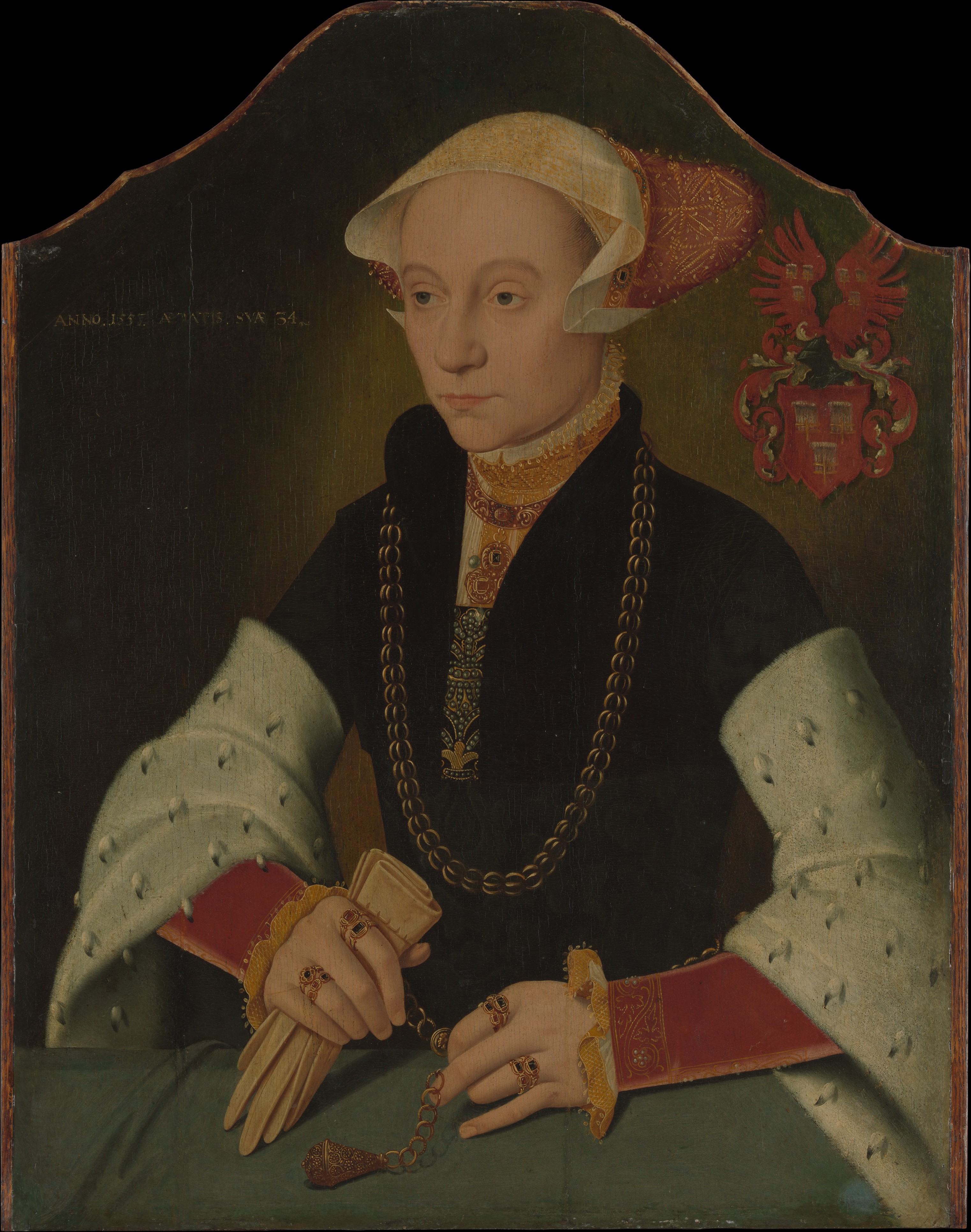
However this is not what we see in the Juelich figures. And the Codies fortunately shows figures with sleeves of this arrangement to compare the treatment of this kind of turn back.
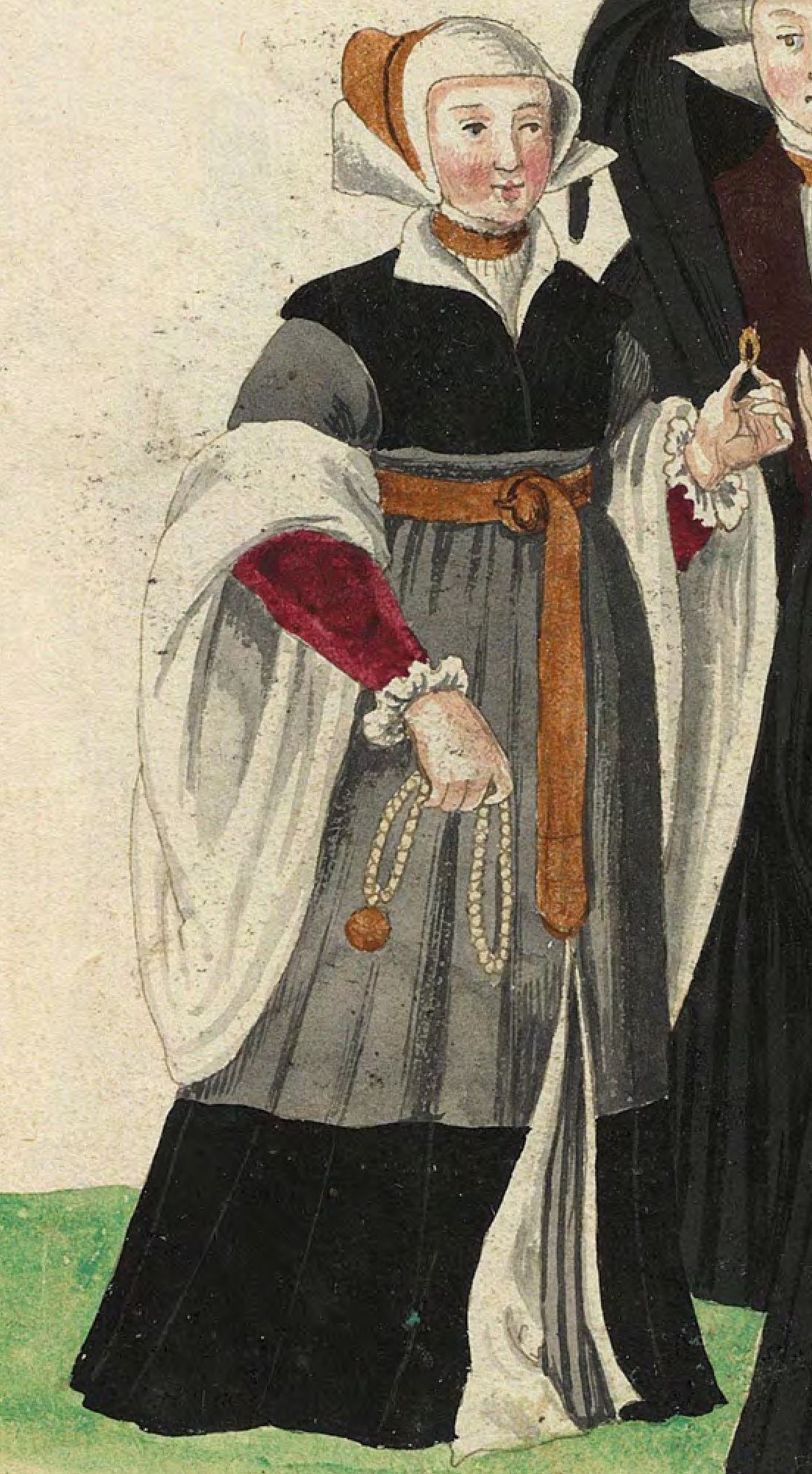
1540s Cologne Burger. Fig. 1, plate 45r, Codice de trajes, Christoph Weiditz. BNE bdh0000052132 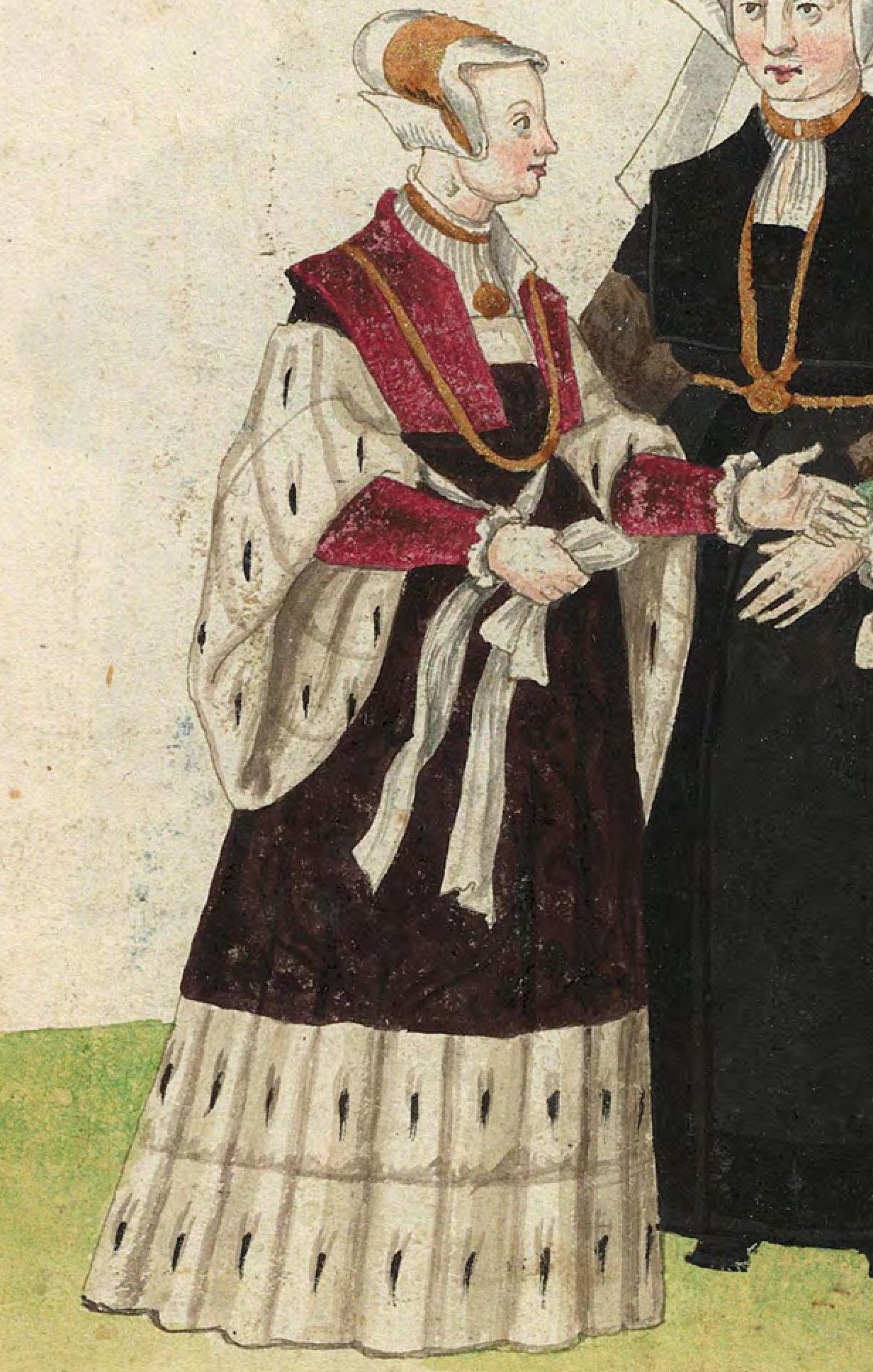
1540s Cologne Burger. Fig. 1, plate 44r, Codice de trajes, Christoph Weiditz. BNE bdh0000052132 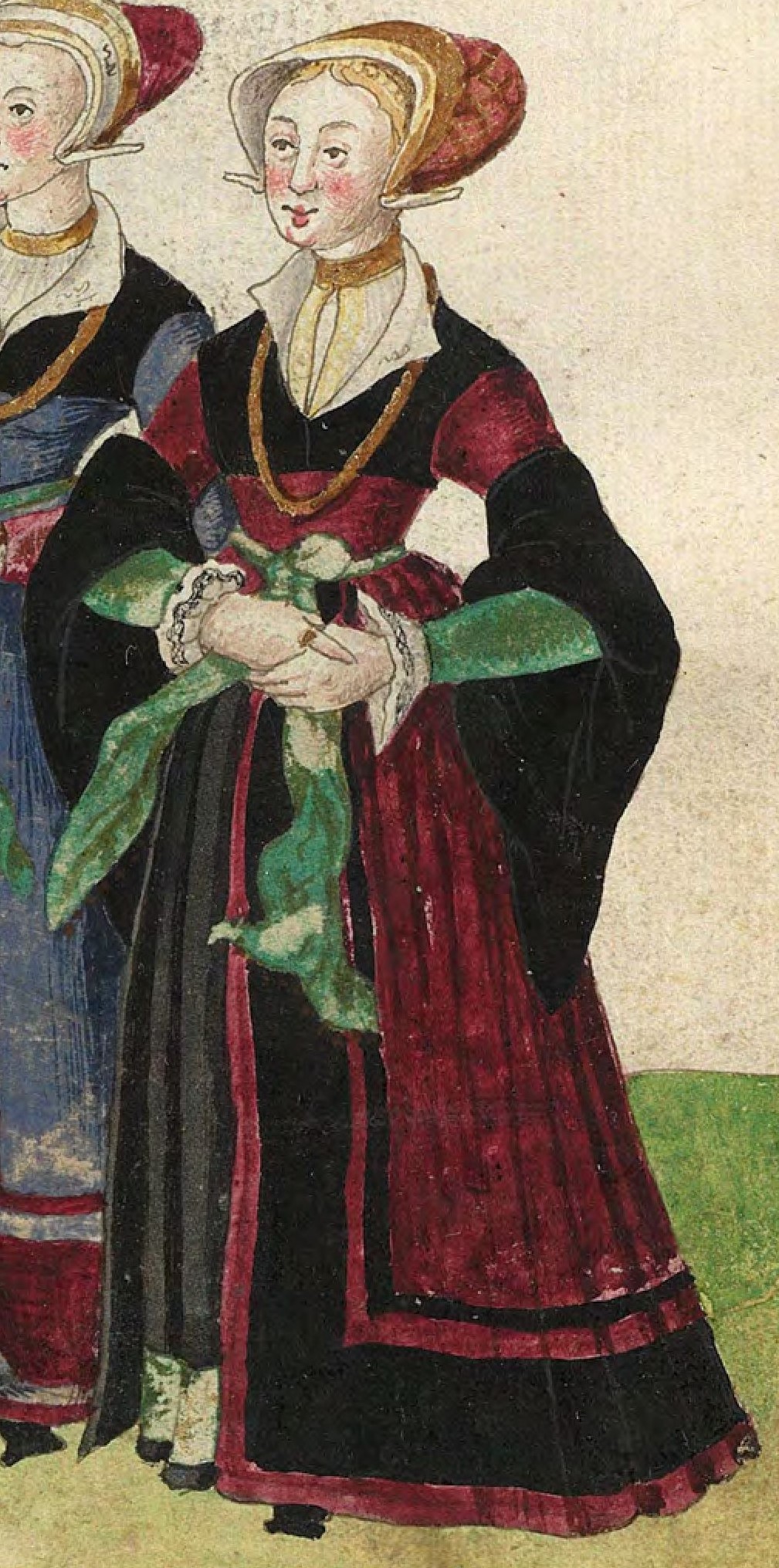
1540s Gelders nobility. Fig. 3, plate 33r, Codice de trajes, Christoph Weiditz. BNE bdh0000052132 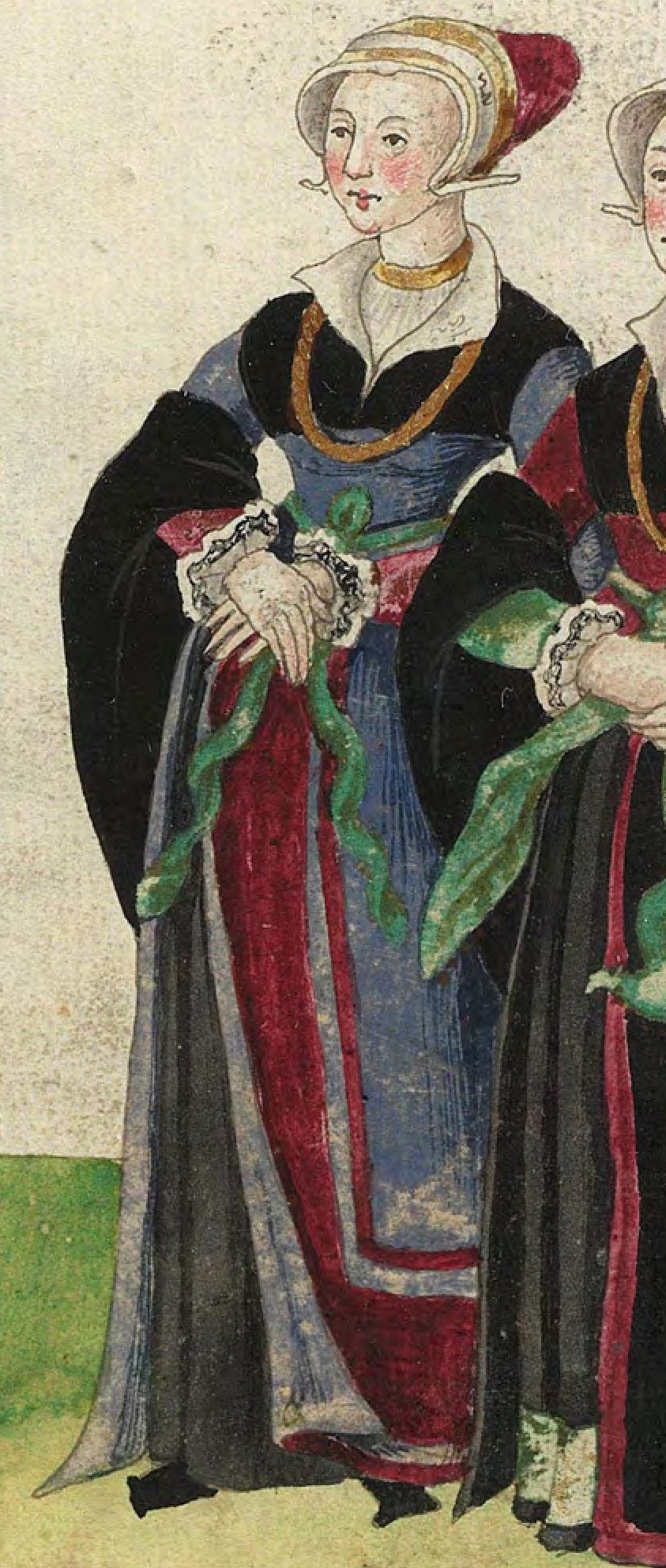
1540s Gelders nobility. Fig. 2, plate 33r, Codice de trajes, Christoph Weiditz. BNE: bdh0000052132 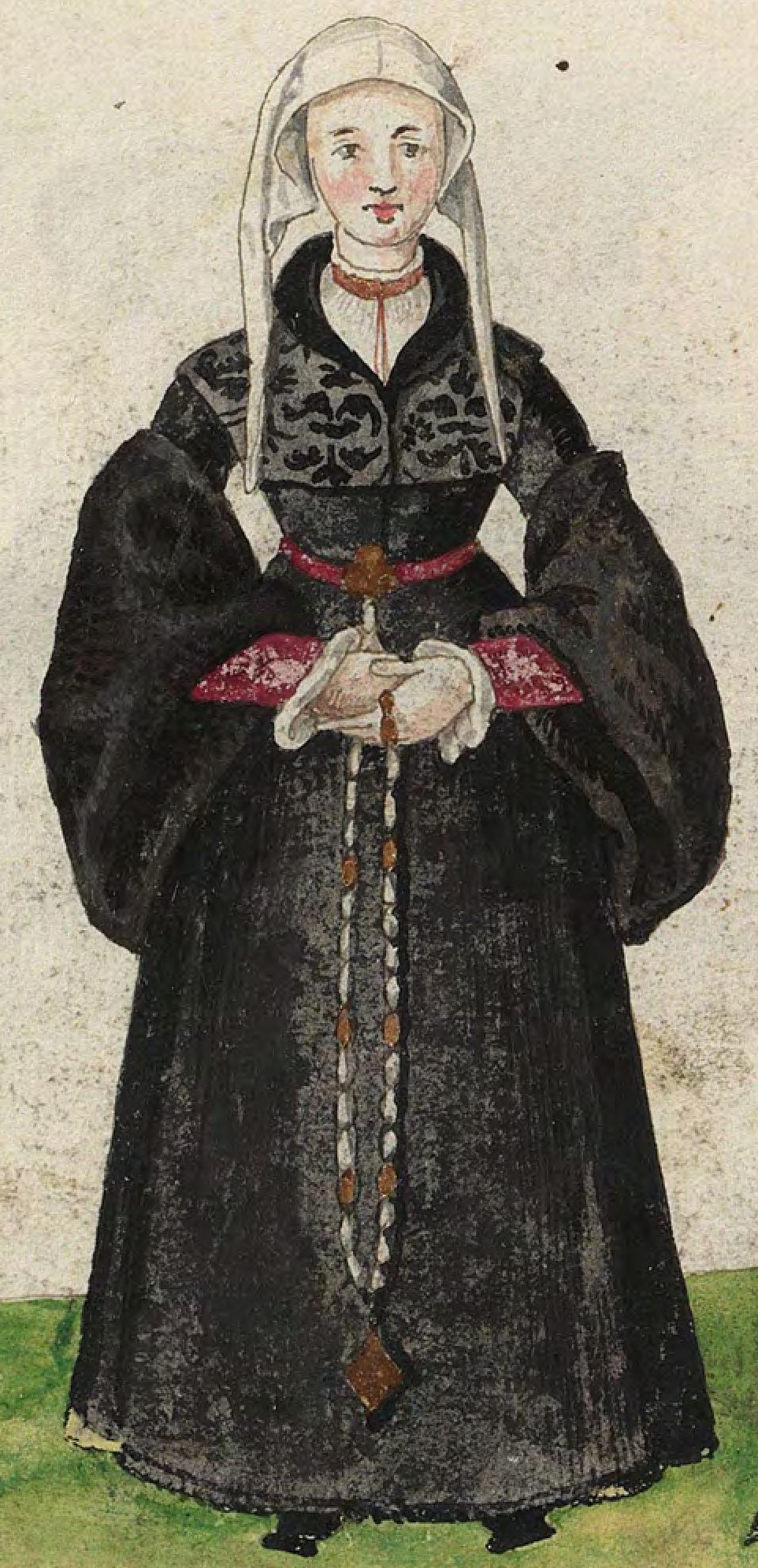
1540s Gelders Burger. Fig. 1, plate 33v, Codice de trajes, Christoph Weiditz. BNE bdh0000052132 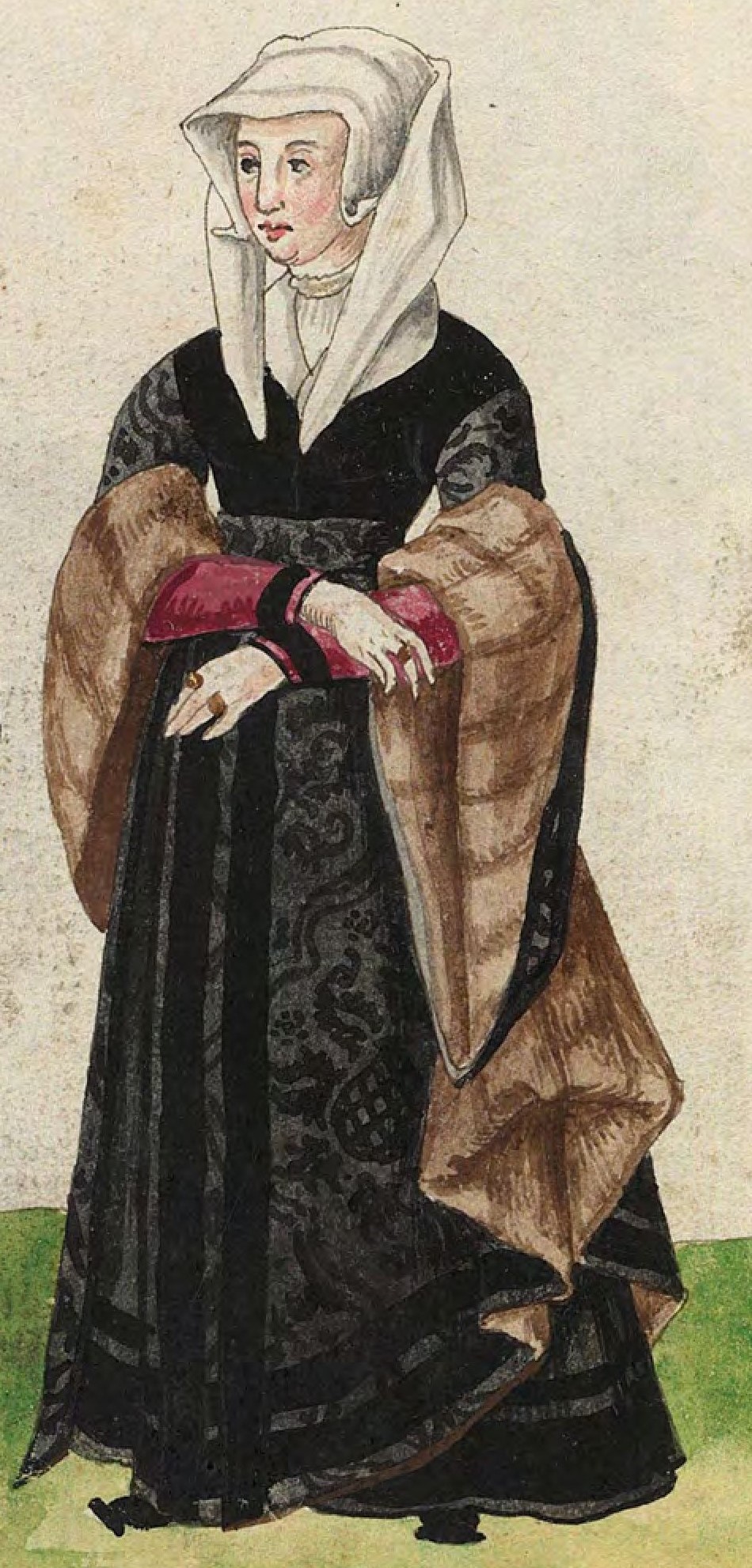
1540s Gelders Burger. Fig. 2, plate 33v, Codice de trajes, Christoph Weiditz. BNE bdh0000052132
In the Juelich figures we can see vertical gathers on the white hanging sleeve where it meets the fitted upper sleeve which does not indicate that the sleeves are pinned over.
I thought perhaps the way the book was created was from sketches Weiditz created during his travel and then he copied those into his book, thus maybe he did not take note of the colour of the hanging sleeves. His first book has been extensively studied but not this second so I am working with a lot of assumptions here!
I may be right, as the last figure (pink with black guards) is missing colour on her shoulder to our left. And the figure in yellow has some darker paint on her shoulder to our right which may indicate some trouble.
However this kind of separate soft and hanging sleeve is seen all over artwork of saints and allegorical figures and it does appear in different forms on portraits of women.
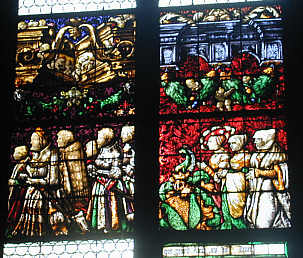
Freiburg, Münster, Stürzel Chapel, Stained Glass 1528 (Hans von Rapstein, Rappoltstein) after design by Hans Baldung Grien (copy, original in Augustinermuseum.)
These figures are not North Rhine but they are of the family of the founder of the Chapel. And the female figure in the middle of the right panel is wearing an example of the loose separate sleeve.
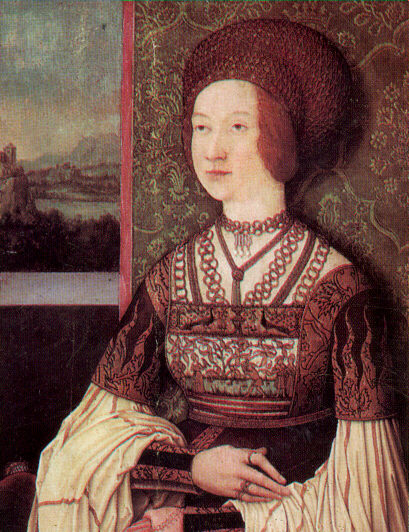
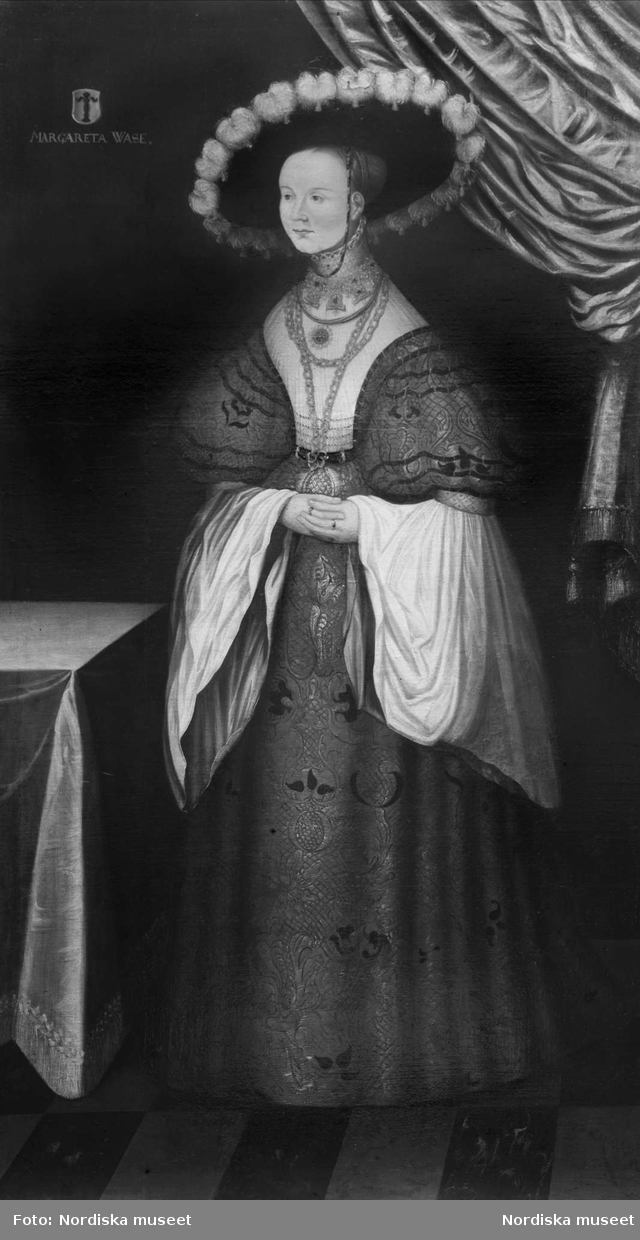
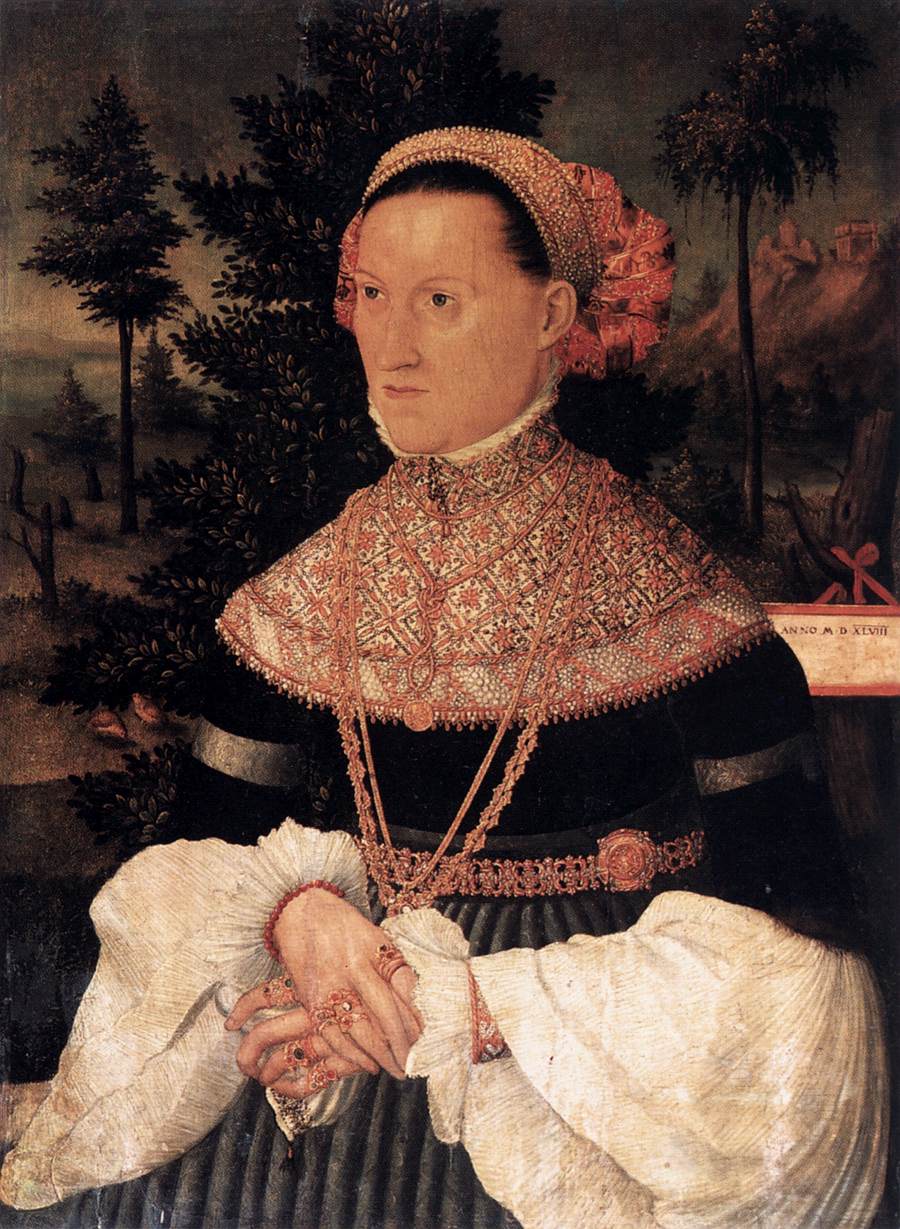
This is not conclusive obviously, however these sleeves are seen from the south to the north of the Rhine and so might be a kind of shared fashion.
It is tempting to call these “stoichen” after a term used in Cologne inventories as this has been taken to mean a kind of pendant sleeve. I had originally thought perhaps they were matching sleeves as the de Bruyn costume book shows quitely clearly little fasteners on several loose sleeves that match the same sort of detail seen on fitted sleeves (though they look like thumb tacks not pins.) I suspect this is still a term for the type of sleeve even if not a separate item.
![1581 Cleves. Fig. 1, page 17, Omnium pene Europae, Asiae, Aphricae, Americae gentium habitus [...] de Bruyn. Rijsmuseum BI-1895-3811](http://www.arrayedindreams.com/wp-content/uploads/2018/09/1581-debruyn-rijks-17-1.jpg)
1581 Cleves. Fig. 1, page 17, Omnium pene Europae, Asiae, Aphricae, Americae gentium habitus […] de Bruyn. Rijsmuseum BI-1895-3811 ![1581 Cologne, unmarried woman. Fig. 3, page 16, Omnium pene Europae, Asiae, Aphricae, Americae gentium habitus [...] de Bruyn. Rijsmuseum BI-1895-3811](http://www.arrayedindreams.com/wp-content/uploads/2018/09/1581-debruyn-rijks-16.jpg)
1581 Cologne, unmarried woman. Fig. 3, page 16, Omnium pene Europae, Asiae, Aphricae, Americae gentium habitus […] de Bruyn. Rijsmuseum BI-1895-3811 ![1581 Aachen, unmarried girl. Fig. 9, page 18, Omnium pene Europae, Asiae, Aphricae, Americae gentium habitus [...] de Bruyn. Rijsmuseum BI-1895-3811](http://www.arrayedindreams.com/wp-content/uploads/2018/09/1581-debruyn-rijks-18-9.jpg)
1581 Aachen, unmarried girl. Fig. 9, page 18, Omnium pene Europae, Asiae, Aphricae, Americae gentium habitus […] de Bruyn. Rijsmuseum BI-1895-3811 ![1581 Cologne, bride. Fig. 2, page 11, Omnium pene Europae, Asiae, Aphricae, Americae gentium habitus [...] de Bruyn. Rijsmuseum BI-1895-3811](http://www.arrayedindreams.com/wp-content/uploads/2018/09/1581-debruyn-rijks-11-2.jpg)
1581 Cologne, bride. Fig. 2, page 11, Omnium pene Europae, Asiae, Aphricae, Americae gentium habitus […] de Bruyn. Rijsmuseum BI-1895-3811 ![1581 Cleves, unmarried woman. Fig. 3, page 17, Omnium pene Europae, Asiae, Aphricae, Americae gentium habitus [...] de Bruyn. Rijsmuseum BI-1895-3811](http://www.arrayedindreams.com/wp-content/uploads/2018/09/1581-debruyn-rijks-17-3.jpg)
1581 Cleves, unmarried woman. Fig. 3, page 17, Omnium pene Europae, Asiae, Aphricae, Americae gentium habitus […] de Bruyn. Rijsmuseum BI-1895-3811 ![1581 Cleves. Fig. 2, page 17, Omnium pene Europae, Asiae, Aphricae, Americae gentium habitus [...] de Bruyn. Rijsmuseum BI-1895-3811](http://www.arrayedindreams.com/wp-content/uploads/2018/09/1581-debruyn-rijks-17-2.jpg)
1581 Cleves. Fig. 2, page 17, Omnium pene Europae, Asiae, Aphricae, Americae gentium habitus […] de Bruyn. Rijsmuseum BI-1895-3811
But here we do see that a short half length sleeve not only was in fashion in the later half of the century but also it does make for a very versatile garment. Sumptuary laws clearly show that the accessories were a very strong indicator of rank and so were very important. By alternating accessories and wearing the skirt open or closed the one dress can be worn in many ways.
Short half sleeves can also be seen in paintings. The earliest I’ve found is on a child before 1550 and then on adults after this date. These all are puffed not fitted.
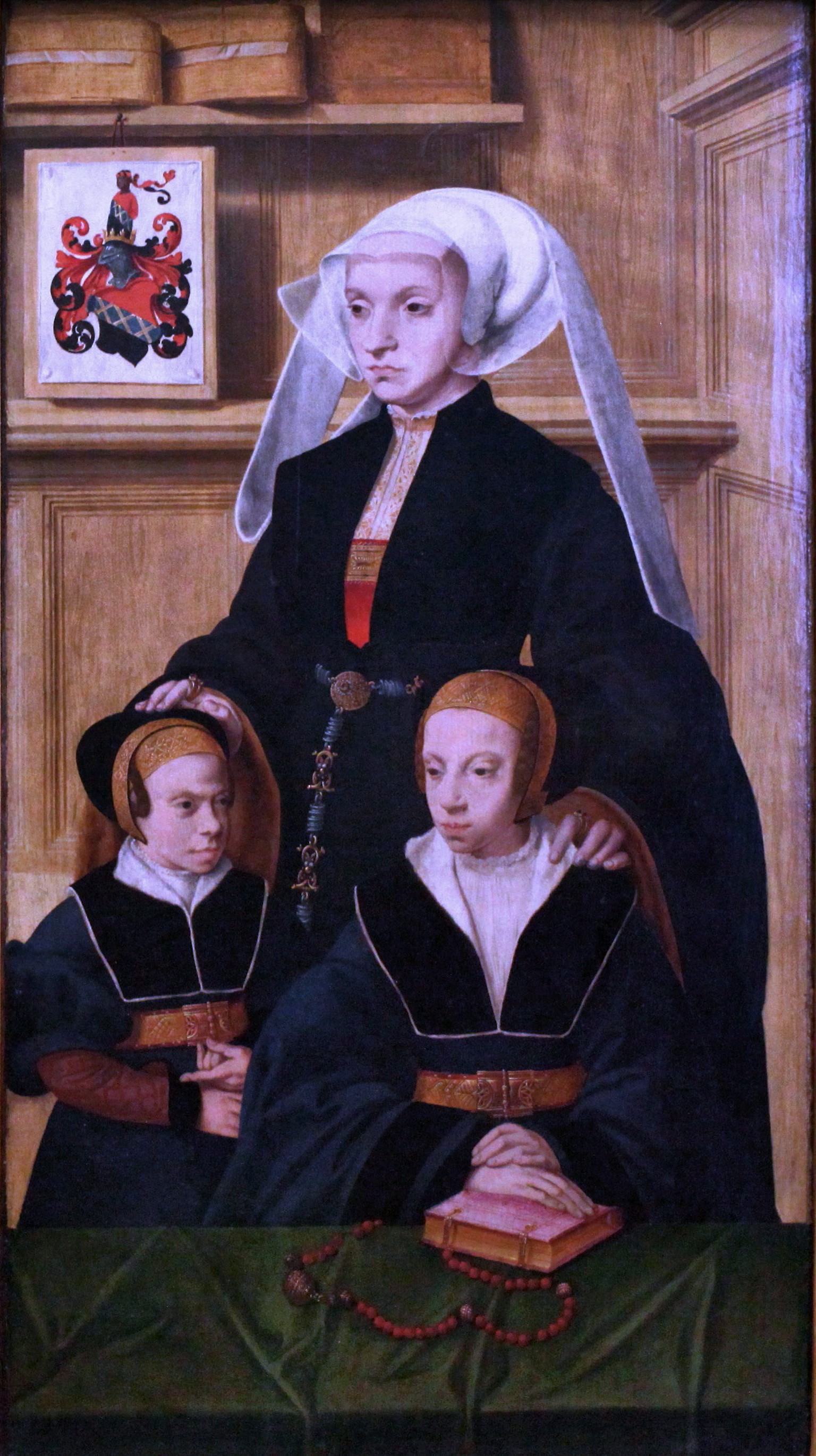
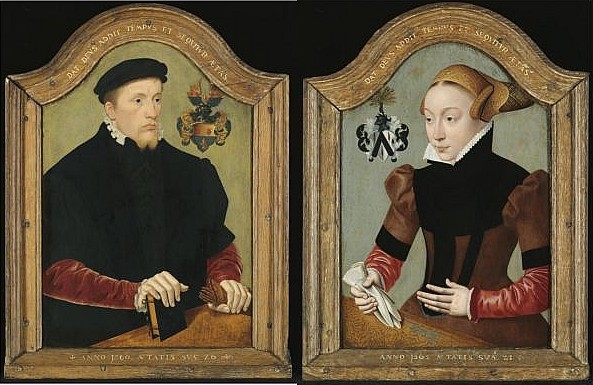
Sophia Von Wedigh in 1557.
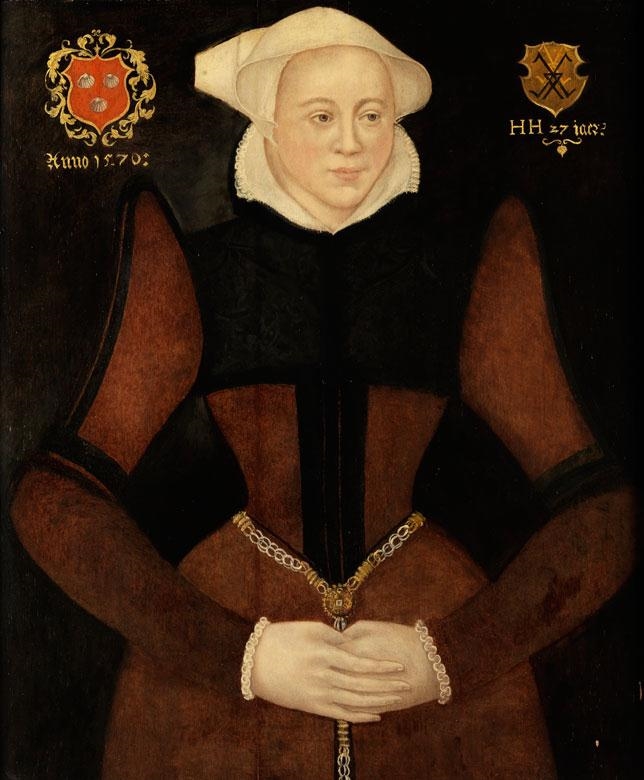
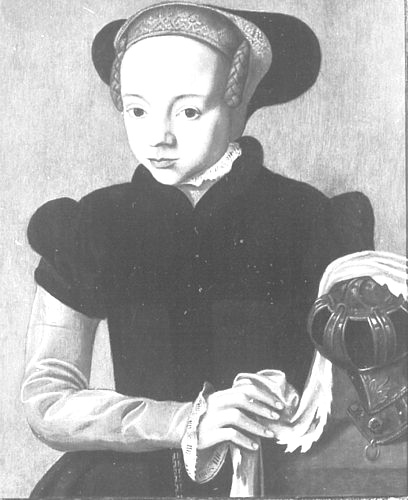
But what of the paned sleeves? These are seen on both figures of Anna and Amela in the triptych of their family, while the rest of their court ladies have loose sleeves.
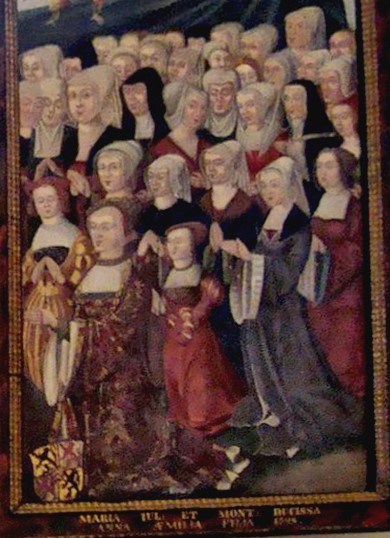
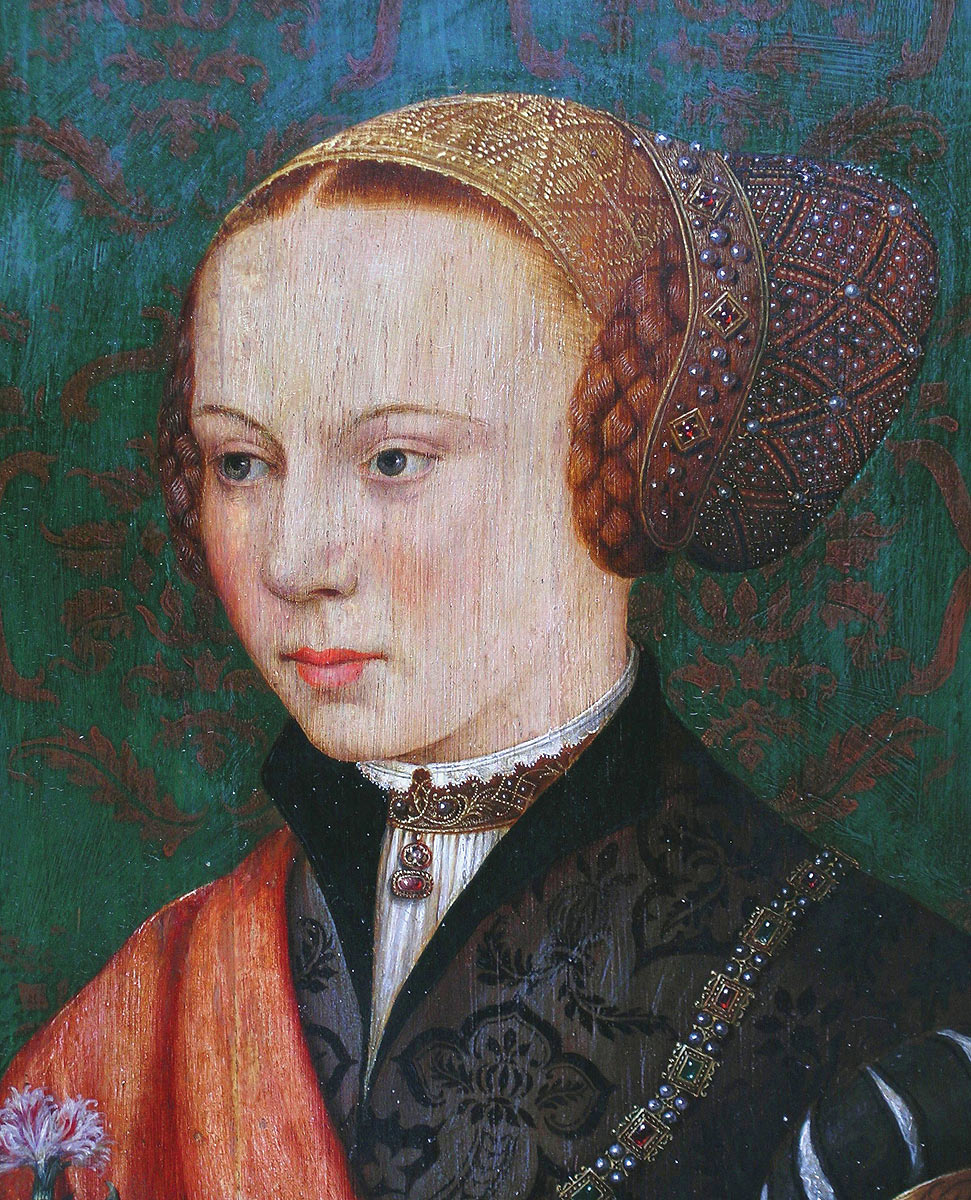
This last portrait is frustratingly difficult to find the original. It was part of an auction on a site that no longer hosts the originals nor any information about the auction, and this is a zoomed view. But there is a very clear paned upper sleeve seen here. This is from a pair of portraits thought to be by the Bruyn workshop. They may have been restored or they may be copies as they do not have the same softness of features.
The half length paned sleeve is seen in allegorical and religious figures especially in sculpture.
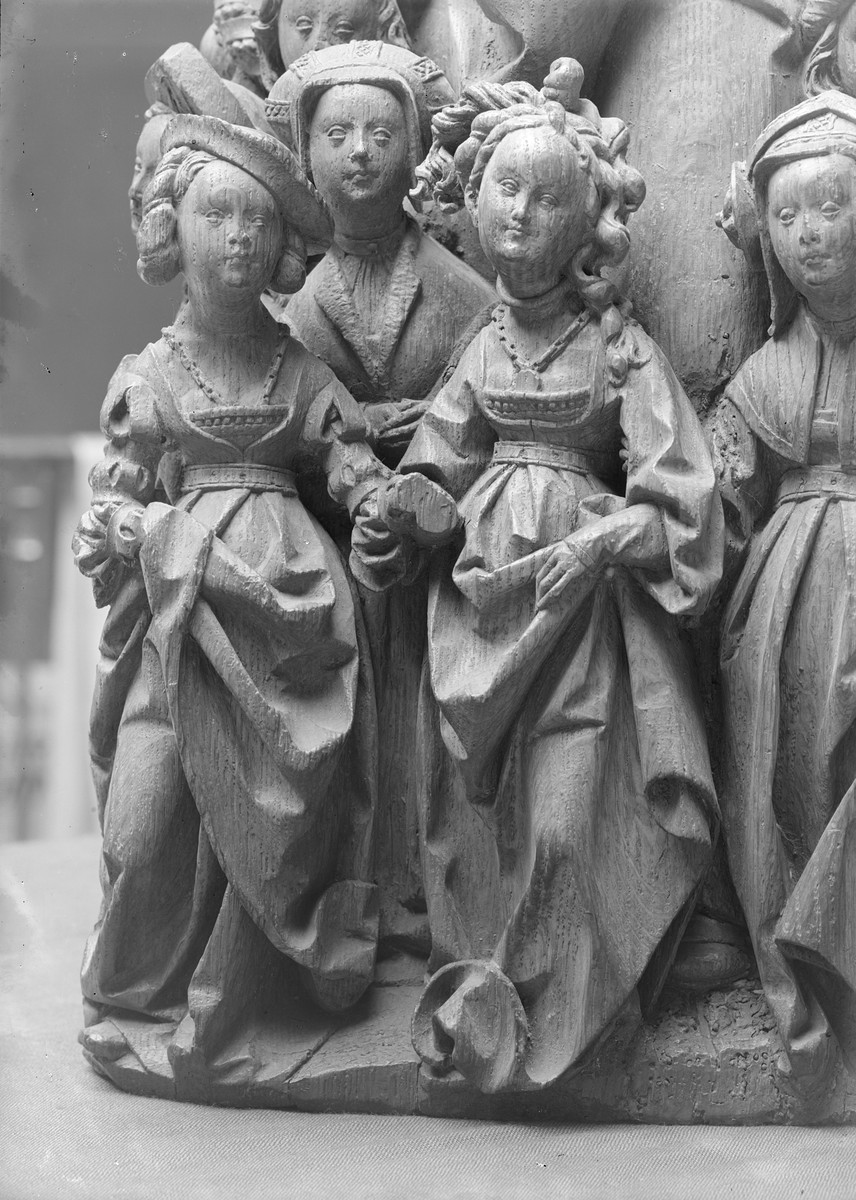
Heilige Ursula mit ihren Jungfrauen
Hersteller:Meister von Osnabrück, Bildhauer
Datierung:um 1510/1520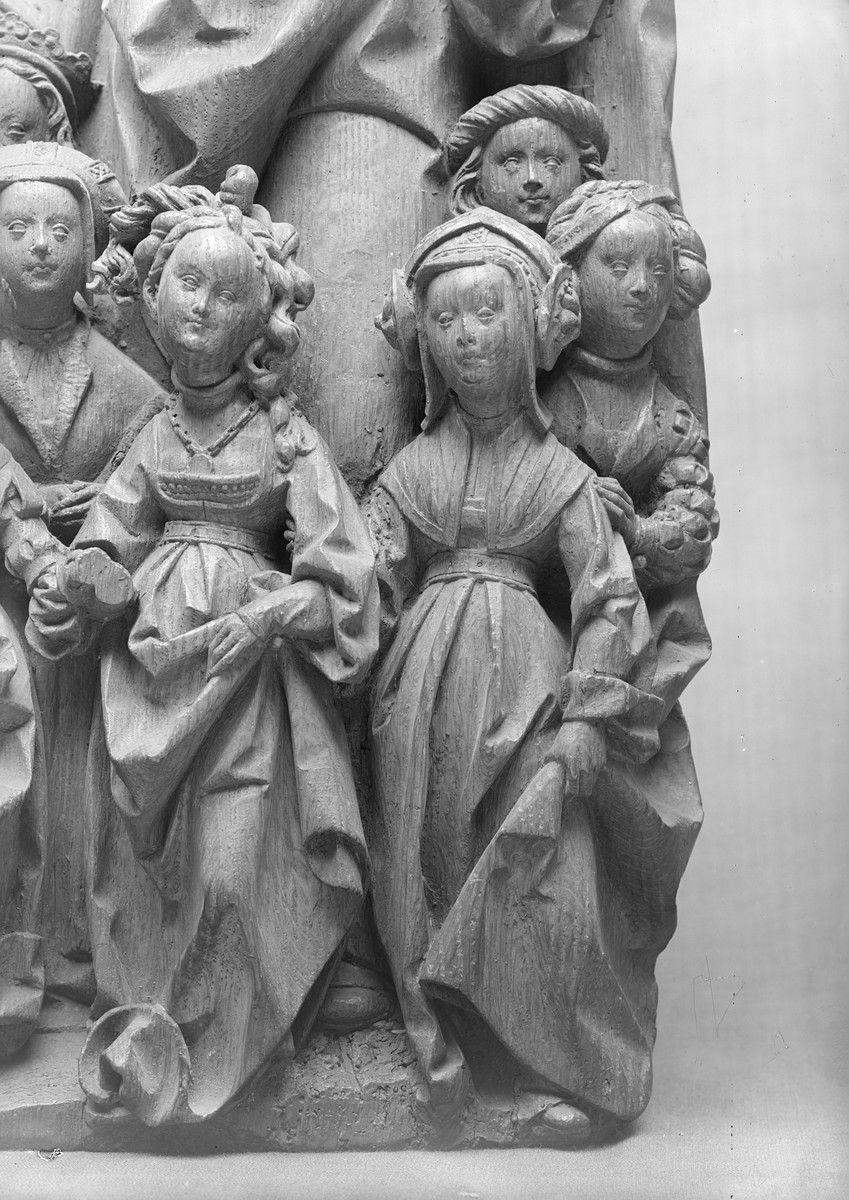
Heilige Ursula mit ihren Jungfrauen
Hersteller:Meister von Osnabrück, Bildhauer
Datierung:um 1510/1520
Of special note is the figure on the far left as she has the same style of hat Anne wears in the triptych. A different kind of cap is also seen on a portrait of the Countess Emeza von Kappenberg as a sketch and detail of the Xantener altar.
JOURNAL ARTICLE: BILDNISZEICHNUNGEN VON BARTHOLOMÄUS BRUYN D. Ä. HILDEGARD KRUMMACHER Wallraf-Richartz-Jahrbuch Vol. 26 (1964), pp. 59-72. Note the braid is part of the figure behind her, also dressed in contemporary dress and likely another contemporary person.
The figure to the right of the group of three even has sleeves quite similar to the portrait of Maria (the mother of Sibylla, Anna, and Amalia.)

On balance it does seem more likely that Weiditz had access to images or people that are no longer represented clearly in the art we can easily access now. However elements of the style can be found both within the North Rhine and outside.
